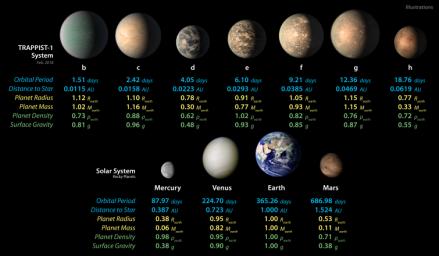
|
TRAPPIST-1 Planet Lineup - Updated Feb. 2018
- Click the image above for a larger view
- Full-Res JPEG (6000 x 3500) (1.1 MB)
- Full-Res TIFF (6000 x 3500) (9.1 MB)
Caption:
This chart shows, on the top row, artist concepts of the seven planets of TRAPPIST-1 with their orbital periods, distances from their star, radii, masses, densities and surface gravity as compared to those of Earth. These numbers are current as of February 2018.
On the bottom row, the same numbers are displayed for the bodies of our inner solar system: Mercury, Venus, Earth and Mars. The TRAPPIST-1 planets orbit their star extremely closely, with periods ranging from 1.5 to only about 20 days. This is much shorter than the period of Mercury, which orbits our sun in about 88 days.
This image is an update to PIA21425 .
The masses and densities of the TRAPPIST-1 planets were determined by careful measurements of slight variations in the timings of their orbits using extensive observations made by NASA's Spitzer and Kepler space telescopes, in combination with data from Hubble and a number of ground-based telescopes. These measurements are the most precise to date for any system of exoplanets.
In this illustration, the relative sizes of the planets are all shown to scale.
For additional information on the Kepler and the K2 mission, visit www.nasa.gov/Kepler .
Background Info:
NASA's Jet Propulsion Laboratory, Pasadena, California, manages the Spitzer Space Telescope mission for NASA's Science Mission Directorate, Washington. Science operations are conducted at the Spitzer Science Center at Caltech, also in Pasadena. Spacecraft operations are based at Lockheed Martin Space Systems Company, Littleton, Colorado. Data are archived at the Infrared Science Archive housed at Caltech/IPAC. Caltech manages JPL for NASA.
For additional information about the Spitzer mission, visit http://www.nasa.gov/spitzer and http://spitzer.caltech.edu .
For additional information about exoplanets, visit https://exoplanets.nasa.gov/ .
Cataloging Keywords:
| Name | Value | Additional Values |
|---|---|---|
| Target | TRAPPIST-1 | |
| System | TRAPPIST-1 | |
| Target Type | Exoplanet | |
| Mission | Spitzer Space Telescope | Hubble Space Telescope (HST), Kepler |
| Instrument Host | Spitzer Space Telescope | TRAPPIST, Hubble Space Telescope, Kepler |
| Host Type | Space Telescope | Ground-Based Telescope |
| Instrument | ||
| Detector | ||
| Extra Keywords | Artwork, Color, Infrared, Orbit | |
| Acquisition Date | ||
| Release Date | 2018-02-05 | |
| Date in Caption | ||
| Image Credit | NASA/JPL-Caltech | |
| Source | photojournal.jpl.nasa.gov/catalog/PIA22094 | |
| Identifier | PIA22094 | |
